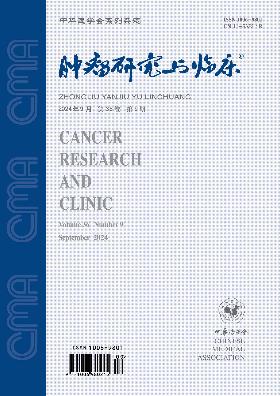Clinical application of sentinel lymph node biopsy in patients with early breast cancer after local excision surgery
Q4 Medicine
引用次数: 0
Abstract
Objective To explore the clinical application value of sentinel lymph node biopsy (SLNB) in patients with early breast cancer after local excision surgery. Methods A total of 93 breast cancer patients with clinical stage Tis/T1-2N0M0 who underwent SLNB and were confirmed by using tumor mass excision biopsy from March 2012 to November 2018 in Shanxi Bethune Hospital were retrospectively analyzed. According to the postoperative paraffin pathology, the patients who were successfully detected sentinel lymph node (SLN) were divided into SLN-positive group with metastasis or SLN-negative group without metastasis. The clinicopathological data were used to analyze influencing factors of SLN metastasis and SLN detection number after excision biopsy of breast masses in the two groups. Results A total of 87 out of 93 patients were successfully detected SLN and the detection rate was 93.5% (87/93). A total of 255 SLN were detected, and the average number was 2.93 in per patient. All were subjected to rapid intraoperative freezing pathological, and 11 cases with positive SLN were detected. There were 17 patients who underwent axillary lymph node dissection (ALND), including 11 cases with positive SLN and 6 cases with SLN undetected. The paraffin pathology showed that 14 patients were confirmed as positive SLN, including 13 macrometastasis and 1 micrometastasis. The SLN false negative rate was 2.1% (3/14) of intraoperative frozen diagnosis. Univariate analysis showed that histological grade and intravascular thrombus of carcinoma were associated with SLN metastasis after breast cancer local excision; the number of SLN detection was effected by body mass index and staining method; the methylene staining method combined with radionuclide method could improve the detection rate of SLN (all P < 0.05). Multivariate analysis showed that the SLN non-detection of obesity patients was 2.651 times as much as that of normal patients (95% CI 1.592-8.194, P=0.010). Conclusion The SLNB and appropriate tracer method will have a high SLN detection rate and better clinical application value for early breast cancer patients after breast mass resection. Key words: Breast neoplasms; Mastectomy; Sentinel lymph node biopsy早期乳腺癌症局部切除术后前哨淋巴结活检的临床应用
目的探讨前哨淋巴结活检(SLNB)在早期乳腺癌局部切除术后的临床应用价值。方法回顾性分析2012年3月至2018年11月山西白求恩医院93例临床分期ti /T1-2N0M0行SLNB并经肿瘤肿块切除活检证实的乳腺癌患者。根据术后石蜡病理将成功检出前哨淋巴结(SLN)的患者分为有转移的SLN阳性组和无转移的SLN阴性组。通过临床病理资料分析两组乳腺肿块切除活检后SLN转移及SLN检测数的影响因素。结果93例患者中87例成功检出SLN,检出率为93.5%(87/93)。共检测到SLN 255个,平均2.93个/例。所有患者均行术中快速冷冻病理检查,其中11例SLN阳性。17例患者行腋窝淋巴结清扫术(ALND),其中11例SLN阳性,6例未检出SLN。石蜡病理证实14例SLN阳性,其中大转移13例,微转移1例。术中冷冻诊断SLN假阴性率为2.1%(3/14)。单因素分析显示,乳腺癌局部切除后肿瘤的组织学分级和血管内血栓与SLN转移相关;体质指数和染色法影响SLN的检测数量;亚甲基染色法联合放射性核素法可提高SLN的检出率(P < 0.05)。多因素分析显示,肥胖患者的SLN未检出率是正常患者的2.651倍(95% CI 1.592 ~ 8.194, P=0.010)。结论SLNB及合适的示踪方法对乳腺肿块切除术后的早期乳腺癌患者具有较高的SLN检出率和较好的临床应用价值。关键词:乳腺肿瘤;乳房切除术;前哨淋巴结活检
本文章由计算机程序翻译,如有差异,请以英文原文为准。
求助全文
约1分钟内获得全文
求助全文
来源期刊

肿瘤研究与临床
Medicine-Oncology
CiteScore
0.10
自引率
0.00%
发文量
7737
期刊介绍:
"Cancer Research and Clinic" is a series of magazines of the Chinese Medical Association under the supervision of the National Health Commission and sponsored by the Chinese Medical Association.
It mainly reflects scientific research results and academic trends in the field of malignant tumors. The main columns include monographs, guidelines and consensus, standards and norms, treatises, short treatises, survey reports, reviews, clinical pathology (case) discussions, case reports, etc. The readers are middle- and senior-level medical staff engaged in basic research and clinical work on malignant tumors.
 求助内容:
求助内容: 应助结果提醒方式:
应助结果提醒方式:


